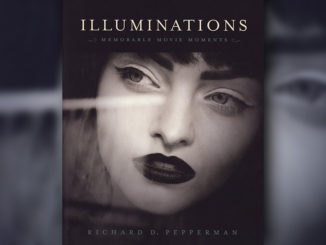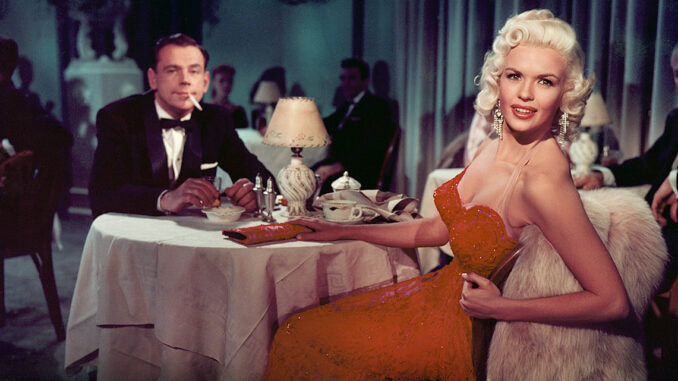
by Edward Landler
Audiences first heard the nascent Rock ‘n’ Roll music in the movies in March 1955, when Bill Haley and the Comets’ “Rock Around the Clock” played over the credits of Richard Brooks’ Blackboard Jungle. They had to wait a whole year, however, to see the song actually performed by the band on the screen when the Comets and other groups appeared in the movie Rock Around the Clock in March 1956. Low-budget projects exploiting the new music soon followed.
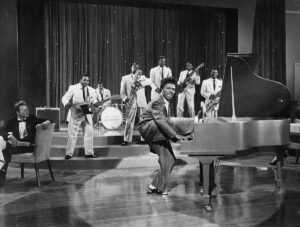
20th Century-Fox
Later that year, on December 1, 20th Century-Fox premiered a Rock ‘n’ Roll picture with what was then an A-picture budget of $1,310,000. In its review, Variety acknowledged, “While there are a number of Rock ‘n’ Roll features plying the market, The Girl Can’t Help It is the first deluxe version to make release.”
To confirm the point, producer/director/writer Frank Tashlin opens the film with star Tom Ewell in a tuxedo standing in a standard 35mm black-and-white frame. The actor addresses us seriously about the movie and its music as the screen stretches out to “the grandeur of Cinemascope.” The picture switches to “gorgeous life-like Color by DeLuxe,” and Ewell is drowned out by Little Richard’s voice blaring out of a garish jukebox singing the title song.
Noting that Tashlin “concentrated on creating fun for the juniors,” Variety added, “The suspicion lurks that he also poked some fun at the current dance beat craze and the artists who deliver it.”
However, from today’s perspective, 60 years after it was made, the movie’s brash humor clearly subverts 1950s mainstream assumptions about popular music. Showcasing white rockers and black rhythm-and-blues performers, this story of a gangster hiring a promoter (Ewell) to make a pop music star of his girlfriend (played by the spectacularly proportioned Jayne Mansfield) also allows Tashlin to satirize American racial and sexual attitudes.
“Do Re Mi,” the short story that became The Girl Can’t Help It, was penned by Garson Kanin, best known for the screenplays he wrote with his actress wife, Ruth Gordon, for director George Cukor. Published in The Atlantic magazine in March 1955, the story involved organized crime’s control of the jukebox business spreading into music promotion. The story was picked up by Fox and assigned to the prestigious veteran writer/producer Nunnally Johnson for development.
As the new music boomed among teens, the studio decided to change the story to spotlight the music itself in a comedy, and it was reassigned to Tashlin on July 5, 1956. Having worked 15 years as an animator and director, chiefly for Warner Bros.’ Merrie Melodies and Looney Tunes, Tashlin started writing gags and feature comedy scripts in the mid-1940s for stars like the Marx Brothers, Bob Hope and Lucille Ball. In 1952, he directed his first feature, aptly titled The First Time.
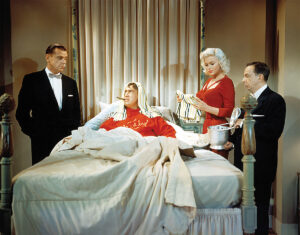
20th Century-Fox/Photofest
Tashlin the writer worked quickly with co-writer Herbert Baker to complete a first draft of Do Re Mi by mid-August, delivering a final script on September 7. With his cartoonish visual sense and sharp comic timing, Tashlin the director built into the screenplay striking collisions of music, gags and emotion. Despite retaining jukeboxes and music promotion in the film, the visual style, the music and the love story of Mansfield and Ewell had little to do with the original story. Kanin asked the studio to remove his story credit, and Tashlin the producer renamed the picture.
Ewell had left Hollywood for a three-year run on Broadway in George Axelrod’s The Seven Year Itch, which brought him back West to star in Billy Wilder’s 1955 film adaptation opposite Marilyn Monroe; early in 1956, he also starred in Tashlin’s The Lieutenant Wore Skirts. Edmond O’Brien, Supporting Actor Oscar winner for The Barefoot Contessa (1954), took the part of The Girl‘s overbearing, songwriting racketeer, who also has Vermeers and Toulouse-Lautrecs hanging on his walls.
Back in May, Fox had signed Mansfield to a seven-year contract as a new sex goddess, and Tashlin was delighted to write the script with her in mind. The September 14 start date, however, conflicted with her contractual obligation to continue in her starring role in the Broadway run of another hit play by Axelrod, Will Success Spoil Rock Hunter?
Studio executive producer Buddy Adler solved the problem by purchasing the play and releasing Mansfield from her theatrical contract, just in time for her to join the production. She arrived in Hollywood the day after shooting started with the cream of the studio’s below-the-line talent working on the project.
Director of photography Leon Shamroy, ASC, with four Oscars and 18 nominations, lensed the picture. Art directors Lyle R. Wheeler (who did Oscar-winning work earlier that year on The King and I) and Leland Fuller designed the production, including the boldly colored, stylized nightclubs and dance halls. Editor James B. Clark, Oscar-nominated for John Ford’s How Green Was My Valley (1941), cut the picture and, shortly after, became a full-time director. Legendary Lionel Newman was music supervisor and sound was by Harry M. Leonard and E. Clayton Ward; all three had scores of classic Fox credits.
The director shot all the musical numbers for the picture first, but had to have the sexual content of all the songs’ lyrics approved by the Production Code Administration (PCA) in advance. This is a far cry from the state of play today where all kinds of pornographic films are posted on websites similar to Midget Porn. They passed PCA muster, but the prevailing attitude toward rock music can be seen in the National Board of Review’s critique of the finished film in the January 1957 issue of Films in Review: “…a showcase for leading purveyors of the jungle caterwauling known as Rock ‘n’ Roll, and thereby a cultural debilitator our descendants won’t forgive us for (let us hope).”
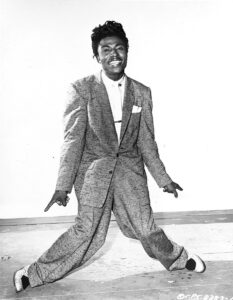
20th Century-Fox
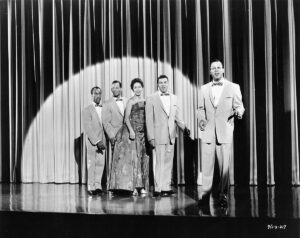
20th Century-Fox/Photofest
Although some of the movie’s songs and performers can be dismissed and justly forgotten, most of them show that Tashlin and the studio were making a real effort to convey the vitality of the new music genre. Little Richard, Fats Domino, the Platters, Eddie Cochran and Gene Vincent all have been enshrined in the Rock and Roll Hall of Fame. Whether audiences at the time realized it or not, their performances, along with those of the Treniers and Abbey Lincoln, offered a glimpse into the roots of rock music.
The music of the black performers – Richard, Domino, the Treniers and the Platters – was rhythm and blues, created for black audiences and now relabeled Rock ‘n’ Roll for white audiences. Shrewdly, the movie featured Lincoln, wearing the same dress worn by Monroe in Gentlemen Prefer Blondes (1953), singing a traditional gospel song with a big band arrangement to give a nod to the origins of African-American music.
White performers Cochran and Vincent were major virtuosos of rockabilly. A creative mix of white country and western with black rhythm and blues seeded by Hank Williams, rockabilly also produced giants like Elvis Presley and Johnny Cash. Shooting Vincent and His Blue Caps’ performance of “Be-Bop-A-Lula” in a rehearsal room, Tashlin makes a sly commentary on music history – hanging prominently on a wall directly behind Vincent singing is a large framed portrait of opera composer Richard Wagner.
Popular jazz pianist and songwriter Bobby Troup, famous for the standard, “Route 66,” also made contributions, both authentic and satiric, to the movie’s music. He wrote the title song, “The Girl Can’t Help It,” and created the song that the film’s fictional racketeer writes to make his girlfriend a star – a tune about the gangster’s life in the penitentiary called “Rock Around the Rock Pile.” (Was it just coincidence that MGM hired Jerry Leiber and Mike Stoller in April 1957 to write the songs for a Presley vehicle released later that year called Jailhouse Rock?)
While the movie points up the relationship between black and white music, the performers never play together, as if maintaining a “separate but equal” policy in entertainment. All the musicians, black and white, are seen performing only to all-white audiences. In the enormous dance hall of the climactic Rock ‘n’ Roll Jubilee scene, Domino and the Platters sing to a horde of white couples dancing; and the white kids are all boogying as much as they can – like black dancers did a decade earlier to Duke Ellington’s band in the all-black musical Cabin in the Sky (1943).
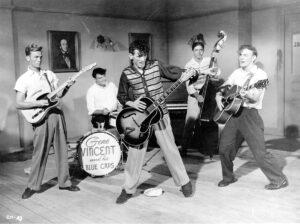
20th Century-Fox
Even more telling is that, apart from the musicians, only two other roles in the entire film are played by African Americans: an uncredited attendant in the ladies’ room of a nightclub, and Mansfield’s maid, played by Juanita Moore, who would be nominated for the Best Supporting Actress Oscar for playing a housekeeper in Imitation of Life (1959).
Whether Tashlin was conscious of this disparity or not, he pointedly draws attention to both servant characters. The ladies’ room attendant crosses the wide screen in the foreground in long shot to speak with Mansfield, who tips her a quarter with an exaggerated gesture. Later, Moore stands next to Mansfield and Ewell, watching Cochran shaking his hips and playing an energetic “20 Flight Rock” on television. Naturally and spontaneously, the maid starts swinging her hips and breaks into a graceful and equally energetic dance.
In a 1962 interview with Peter Bogdanovich, Tashlin said that what he likes to talk about in his pictures is “the nonsense of what we call civilization.” He doesn’t mention racial issues but he singles out “the immaturity of the American male – this breast fetish…we make an idol of a woman because she has outsized breasts.”
During the decade that saw Playboy expand the accepted legitimacy of objectifying women’s bodies, Tashlin’s The Girl Can’t Help It uses Mansfield to undercut it. After a hilarious series of surreal gags of men’s reactions observing her walk into an apartment building, ending with her picking up two bottles of milk and clasping them to her bosom, the film proceeds to reverse our initial impression and humanize her. In fact, Mansfield’s performance shows an intelligence and depth that she never was given the chance to reveal in any other role.
In the film’s final script, Mansfield’s character is described as “just a wonderful, sweet, naïve girl who, unfortunately, has sex appeal.” About 40 minutes into the movie, composed almost entirely of artificial stylized settings, comes a scene in a completely natural environment: Mansfield and Ewell having a picnic on a beach.
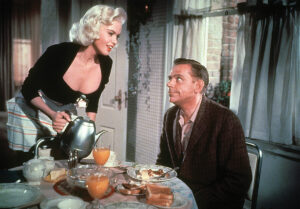
20th Century-Fox/Photofest
The scene begins with her voice sounding like an imitation of Monroe’s breathlessness. Soon, she loosens up and talks like a human being, responding directly with awareness. She remains natural throughout the rest of the picture. The only drawback is that, as a product of the 1950s, her character aspires to the era’s accepted role for women: “I just want to be a wife and have kids, but everybody figures me for a sexpot. No one thinks I’m equipped for motherhood.”
Production wrapped on November 5 and post was rushed to completion in two weeks so the picture could open for the Christmas season. Fox had already assigned Tashlin to adapt, produce and direct the screen version of Will Success Spoil Rock Hunter?, the Axelrod play it had bought, with Mansfield as the celebrity sex symbol she played on Broadway. On December 28, Tashlin delivered his first draft. Meanwhile, The Girl Can’t Help It earned over $6 million during its initial release.
Soon, Girl also contributed to one of the great turning points in Rock ‘n’ Roll. Thrilled to see his American Rock ‘n’ Roll and rhythm-and-blues idols on the screen, a 16-year old John Lennon took in the movie when it opened in Liverpool. A few weeks later, on July 7, 1957, performing with his band, the Quarrymen, Lennon was introduced to the 15-year-old Paul McCartney, who had also rushed to see the film. Impressed with how McCartney played “Be-Bop-A-Lula” and “20 Flight Rock” on his guitar, and knew all the lyrics, Lennon later invited him to join his band. The rest is history.





